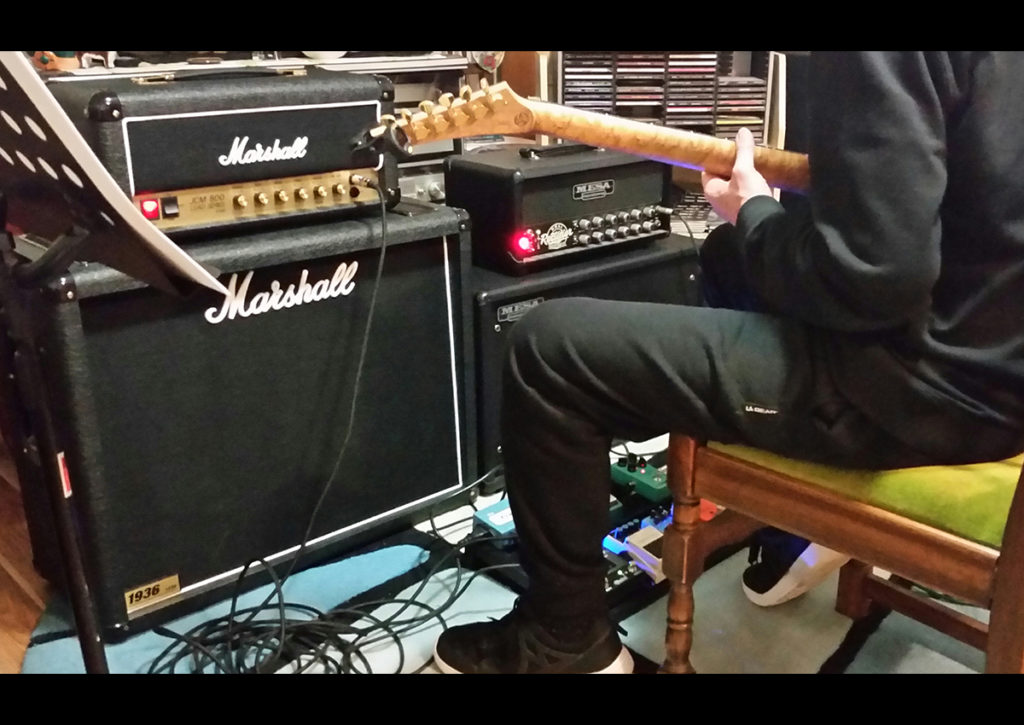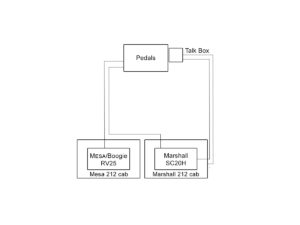
Although long aware of the concept, I was turned on to the idea of using two amps by my dear friend and rag brother (long story), Annemieke Heijne during one of our many gear nerd sessions. Using two small amps and 112 cabs, we dialled up some awesome tones and I decided that it was something that I was definitely going to try at some stage. Fast forward a number of years, and here I am putting my ideas into practise!
The first amp is a Marshall SC20H Studio Series head. It is a faithful recreation of the classic JCM800, and a sound that I am very familiar with – my first ‘big’ amp was a Marshall 2203, purchased in 1979. The SC20H is switchable between 5w and 20w, and even on the lower setting has ‘that’ tone. Being a single channel amp, I have it set so it cleans up nicely with a single coil pickup and gets a bit of grit when pushed with a humbucker. When I kick in my overdrive (more on pedals in a separate post) pedal, I start to get that liquid overdrive the amp is famous for.
There is an effects loop on the back panel, so I have a TC Electronic Hall Of Fame 2 mini reverb pedal sitting on top of the amp. The pedal is always on, and balances with the onboard reverb on my other amp. The head plugs into a Marshall 1936 212 cabinet, which is closed back, solid Birch and quite sizeable for a 212 cab. This enhances the bottom end, so this half of the rig has no problem producing some woof when needed.
 The second amp is a Mesa/Boogie RectoVerb 25 head, and it’s a little beauty. Each of the two channels has two preamp voicings and 10w/25w switching, with reverb controls for each channel on the back panel. Plugged into my Mesa 3/4 back 212 cabinet, this thing has done theatre shows without raising a sweat. Channel 1 can deliver squeaky clean or blues warmth depending on the preamp setting, and channel 2 goes from heavy crunch to full-on Rectifier roar. The 212 cab was part of my Road King rig, used to add some top end to all that Recto thump and tighten up the bass. The RectoVerb has heaps of low end, so this new combination is spot-on. Having been with Mesa since 2006, I’m really at home with their amps, so once I was re-acquainted with the Marshall, I set about blending the two amps (and three channels) to achieve some tones. To date, the results have been delicious. I’ll fill you in on the quest for tone in a separate instalment once the entire rig has been explained. Pedals next!
The second amp is a Mesa/Boogie RectoVerb 25 head, and it’s a little beauty. Each of the two channels has two preamp voicings and 10w/25w switching, with reverb controls for each channel on the back panel. Plugged into my Mesa 3/4 back 212 cabinet, this thing has done theatre shows without raising a sweat. Channel 1 can deliver squeaky clean or blues warmth depending on the preamp setting, and channel 2 goes from heavy crunch to full-on Rectifier roar. The 212 cab was part of my Road King rig, used to add some top end to all that Recto thump and tighten up the bass. The RectoVerb has heaps of low end, so this new combination is spot-on. Having been with Mesa since 2006, I’m really at home with their amps, so once I was re-acquainted with the Marshall, I set about blending the two amps (and three channels) to achieve some tones. To date, the results have been delicious. I’ll fill you in on the quest for tone in a separate instalment once the entire rig has been explained. Pedals next!
